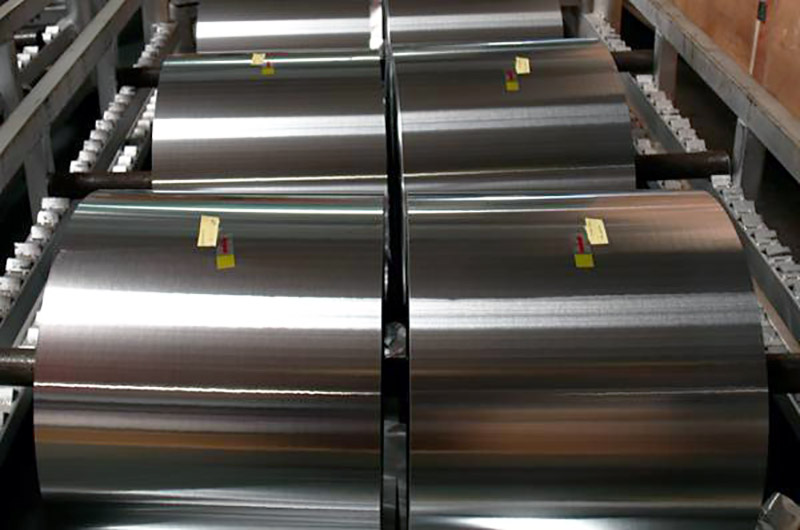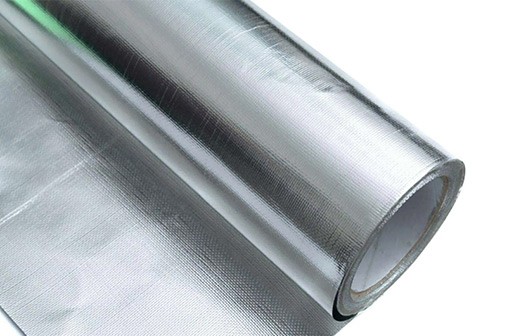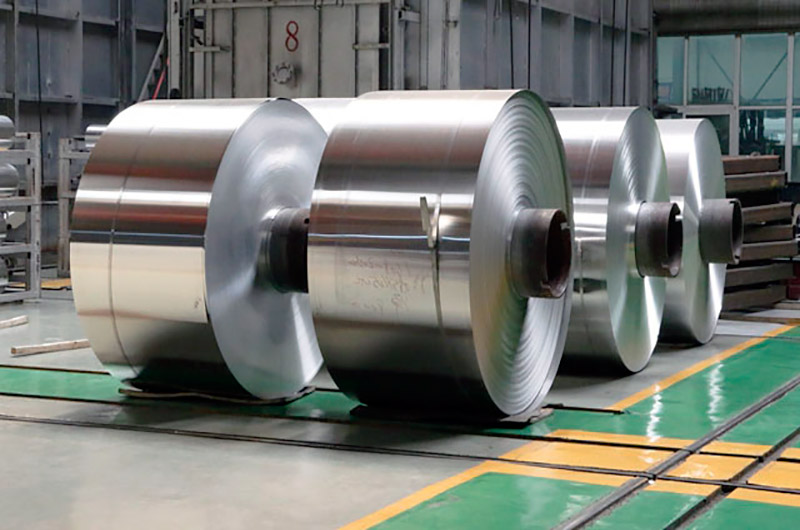- Composition and Principle of Electrolytic Capacitor Aluminum Foil
- Selection of Aluminum Foil Materials for Electrolytic Capacitors
- Electronic Foil Alloy Grades And Specifications
- Advantages of Electrolytic Capacitor Aluminum Foil
- Why Use Aluminum Foil For Electrolytic Capacitor
- Applications of Electrolytic Capacitor Aluminum Foil
- Manufacturing Process of Electrolytic Capacitor Aluminum Foil
- How to make a capacitor out of aluminum foil?
Electrolytic capacitors are essential components in electronic circuits, serving as energy storage devices that store and release electrical energy. These capacitors come in various types, and one of the most widely used is the electrolytic capacitor.
The key component that defines the performance of electrolytic capacitors is the aluminum foil used in their construction.
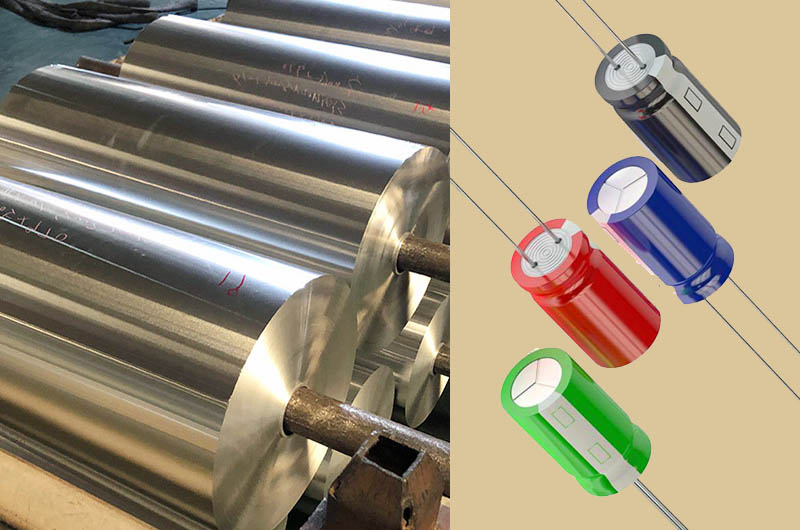
Composition and Principle of Electrolytic Capacitor Aluminum Foil
The anode electrode (+) is typically made from etched pure aluminum foil.
Aluminum foil undergoes anodization to form an ultra-thin layer of aluminum oxide, serving as the dielectric of the capacitor.
The cathode electrode (-) is composed of a second aluminum foil known as "cathode foil, " which contacts the electrolyte and serves as the negative terminal of the capacitor.
The aluminum oxide layer formed by anodization acts as an excellent dielectric between the two conductors. This oxide film not only provides good insulation properties but also withstands certain electrical stresses, enabling stable operation of the capacitor.
Selection of Aluminum Foil Materials for Electrolytic Capacitors
The main aluminum foil materials used include alloys such as 1070, 1100, 3003, and 8011.
These foils undergo special treatments like etching and anodization to ensure surface smoothness and uniformity of the oxide layer, thereby enhancing capacitor performance and reliability.
- 1070 Aluminum Foil for Capacitors: Known for good conductivity and formability, suitable for manufacturing small capacity electrolytic capacitors.
- 1100 Aluminum Foil for Capacitors: Offers excellent corrosion resistance and formability, commonly used for medium capacity electrolytic capacitors.
- 3003 Aluminum Foil for Capacitors: Apart from good conductivity and formability, it also provides strength and corrosion resistance, ideal for manufacturing large capacity electrolytic capacitors.
- 8011 Aluminum Alloy: Features high strength and corrosion resistance, suitable for electrolytic capacitors used in special environmental conditions.
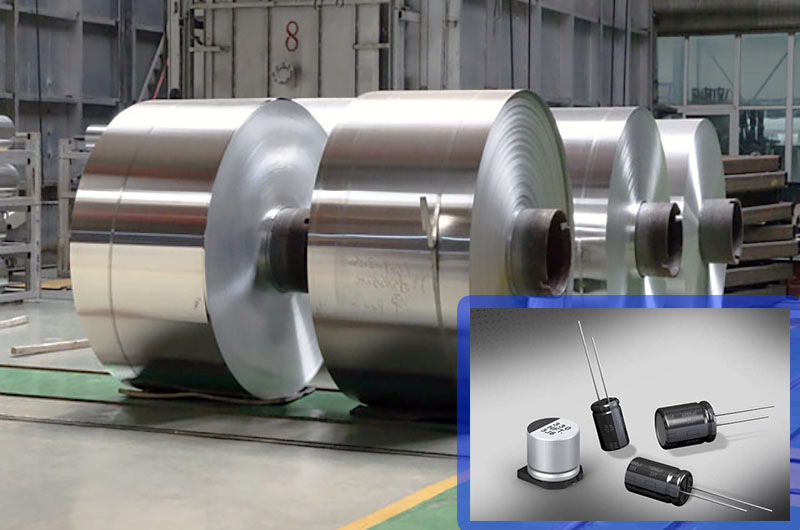
Electronic Foil Alloy Grades And Specifications
In electrolytic capacitors, it is customary to call the negative electrode foil cathode foil. Since the oxide film on the surface of the cathode foil is very thin, increasing the surface area of the cathode foil has little impact on high-voltage capacitors, but it has a greater impact on low-voltage capacitors.
| Alloy: | 1070, 3003 |
|---|---|
| Thickness: | 0.012-0.05mm |
| Width: | 100-1700mm |
| Usage: | Widely used in household appliances, computers, communications, industrial control, electric vehicles, electric locomotives and military and aerospace equipment. |
Advantages of Electrolytic Capacitor Aluminum Foil
1. Low Density
Aluminum is a lightweight metal with low density. This allows aluminum foil-based electrolytic capacitors to maintain sufficient strength and durability while being lightweight, beneficial for lightweight design and portability of electronic products.
2. High Surface Area Ratio
Through the etching process, the surface area of aluminum foil can be significantly increased, creating more micro-grooves and pores. This increased surface area helps improve the capacitance performance of capacitors, as more surface area is available for charge storage between the dielectric and electrodes.
3. High Conductivity
Aluminum is an excellent conductor with good electrical conductivity. This ensures that electrolytic capacitors can efficiently conduct charges, even at high frequencies and currents, thereby providing stable electrical performance and response speed.
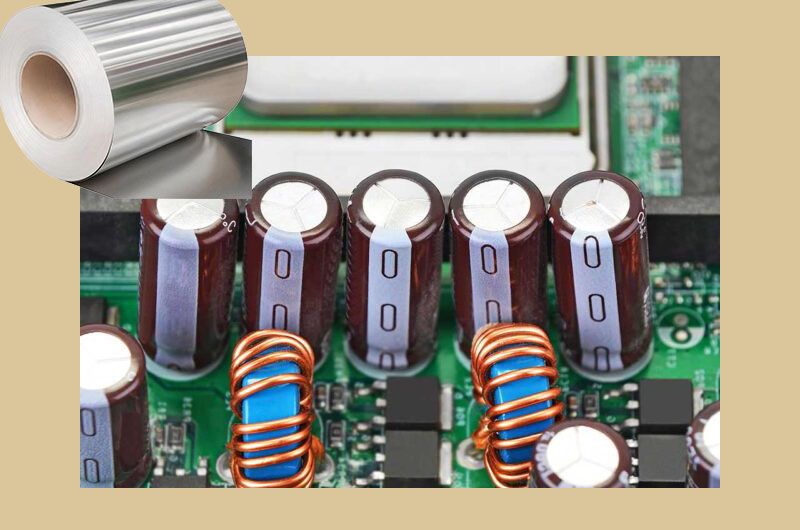
Why Use Aluminum Foil For Electrolytic Capacitor
Aluminum foil is commonly used in the construction of electrolytic capacitors due to its specific characteristics that make it suitable for this application. Electrolytic capacitors are a type of capacitor that uses an electrolyte as one of its plates, and they are widely used in electronic circuits for filtering, coupling, and energy storage.
Here are some reasons why aluminum foil is used for electrolytic capacitors:
1. High Surface Area: Aluminum foil can be manufactured with a high surface area, which is crucial for increasing the capacitance of the electrolytic capacitor. The larger the surface area, the higher the capacitance.
2. Thin and Lightweight: Aluminum foil is thin and lightweight, allowing for the construction of compact and lightweight electrolytic capacitors. This is important for applications where space and weight are critical considerations.
3. High Purity: Aluminum foil used in electrolytic capacitors is typically made from high-purity aluminum to minimize impurities that could affect the capacitor's performance.
4. Anodized Surface: The surface of the aluminum foil used in electrolytic capacitors is usually anodized. Anodization is an electrochemical process that forms a thin, protective oxide layer on the aluminum surface. This oxide layer serves as the dielectric (insulating layer) in the capacitor.
5. High Dielectric Strength: The anodized oxide layer provides a high dielectric strength, allowing the capacitor to withstand higher voltage levels.
6. Stability and Reliability: Aluminum foil has proven to be stable and reliable in electrolytic capacitors, providing consistent performance over time.
Specifications for aluminum foil used in electrolytic capacitors may include parameters such as thickness, purity, surface finish, and the type of electrolyte used in the capacitor. The exact specifications can vary depending on the specific requirements of the capacitor and the manufacturer.
While aluminumsfoil plays a crucial role in enhancing the performance of electrolytic capacitors, there are some challenges and considerations associated with its use. Factors such as temperature, voltage, and ripple current can impact the performance and longevity of the capacitor.
Designers must carefully consider these factors to ensure the proper functioning of the capacitor in diverse applications.
Applications of Electrolytic Capacitor Aluminum Foil
Aluminum electrolytic capacitors are widely used due to their excellent performance, low cost, and broad applicability.
In electronic devices, especially in circuits requiring high stability and long life, aluminum electrolytic capacitors are indispensable components.
- Capacitors
- Speakers
Manufacturing Process of Electrolytic Capacitor Aluminum Foil
The etching process is an electrochemical process that enlarges the surface area of aluminum foil by applying AC or DC current in chloride solutions, preparing it for subsequent anodization.
Aluminum electrolytic capacitors, through precise manufacturing processes and appropriate material selection, can provide stable capacitance performance and long-term reliable operation, thus holding significant importance in the modern electronics industry.
1. Material Selection and Preparation
High purity aluminum foil is chosen as the base material to ensure its electrochemical properties and mechanical strength meet requirements.
Aluminum foils typically undergo specific alloy treatments to optimize their conductivity and corrosion resistance.
2. Etching Process
Etching is part of the electrochemical treatment where aluminum foil is immersed in chloride solutions and subjected to AC or DC current, forming micro-pores and grooves on the aluminum surface.
This process increases the surface area and provides the necessary surface structure for subsequent anodization treatments.
3. Anodization Treatment
After etching, aluminum foil undergoes anodization. This step involves immersing the foil as an anode in a solution containing sulfuric acid or other electrolytes, applying appropriate current density and time.
Anodization forms an oxide layer that enhances the foil's insulation properties, corrosion resistance, and improves surface mechanical properties.
4. Precise Manufacturing Process Control
Throughout the manufacturing process, strict control over foil thickness, surface smoothness, and microstructure is crucial.
This includes using advanced production equipment and techniques to ensure capacitors can deliver stable capacitance performance under various operating conditions.
5. Final Assembly and Encapsulation
After aluminum foil processing, it is cut and assembled into the capacitor structure as per design requirements.
The encapsulation process of electrolytic capacitors typically involves filling with electrolyte, sealing, and testing the final product to meet industry standards and specifications.
How to make a capacitor out of aluminum foil?
Making a simple capacitor using aluminum foil is straightforward. Here's a basic method:
Required materials:
- Aluminum foil (two pieces)
- Dielectric material (such as paper or thin plastic film)
- Conductive leads (wires)
- Insulating material (for separating the aluminum foils)
Steps:
- Cut aluminum foil: Cut two rectangular pieces of aluminum foil. The size of these pieces determines the capacitance (larger area = higher capacitance).
- Prepare dielectric material: Cut a piece of dielectric material (paper or thin plastic film) slightly larger than the aluminum foil pieces. This dielectric material will be placed between the two layers of aluminum foil.
- Assemble layers: Sandwich the dielectric material between the two pieces of aluminum foil. Ensure the aluminum foil pieces do not directly touch each other.
- Connect leads: Attach conductive leads (wires) to each piece of aluminum foil. These will serve as the terminals of the capacitor.
- Insulate: Optionally, cover the sides with insulating material (like tape) to prevent accidental contact between the foil pieces.
- Test: The capacitor is now ready for testing. Measure its capacitance using a capacitance meter or use it in a circuit to observe its effect.

